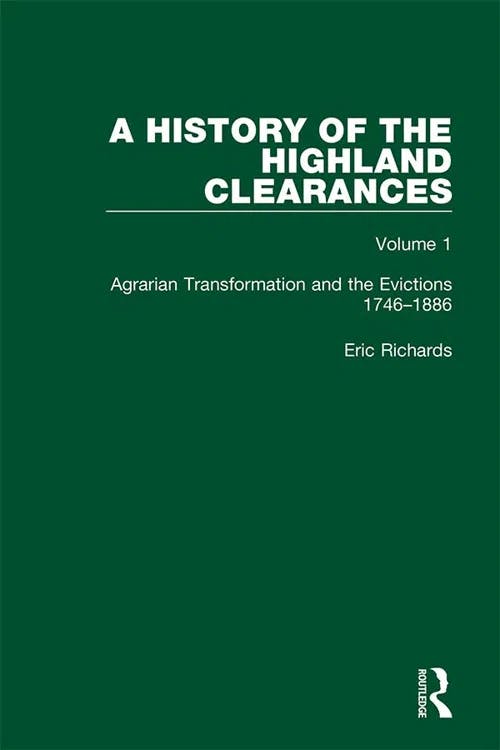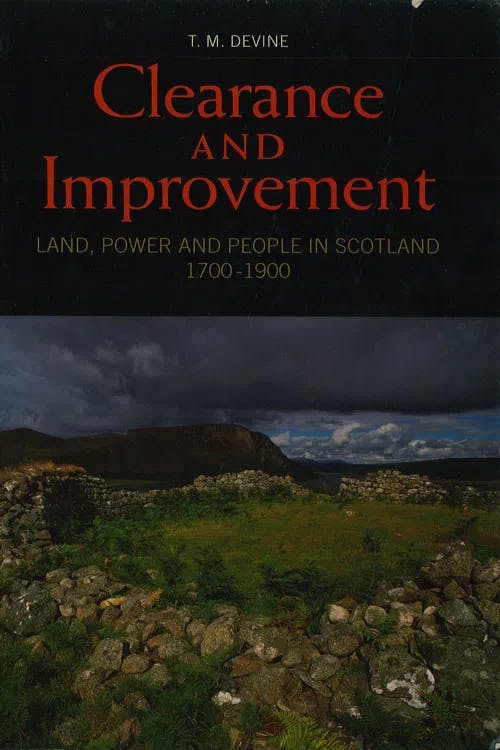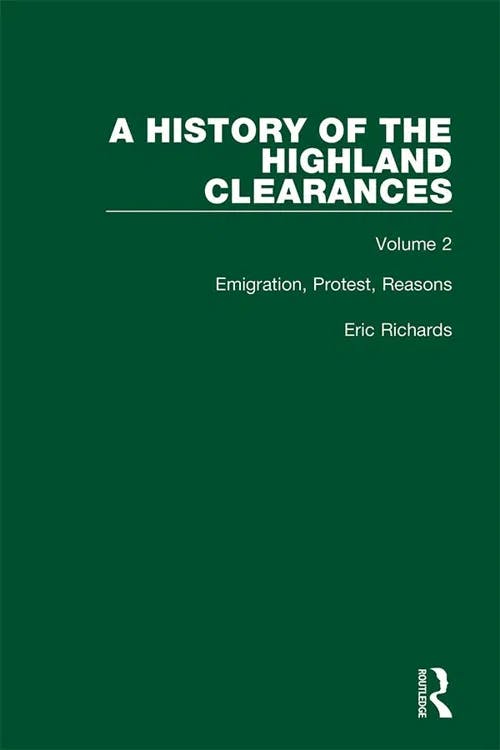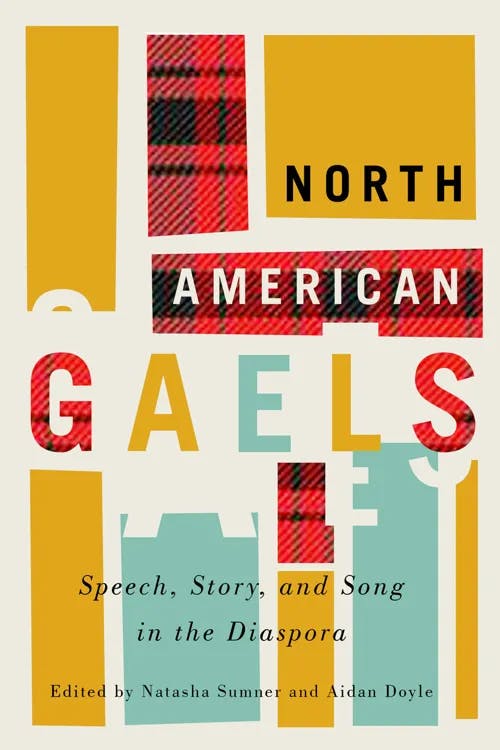What were the Highland Clearances?
MA, History (University of Edinburgh)
Date Published: 07.02.2024,
Last Updated: 19.02.2024
Share this article
Defining the Highland Clearances
Between the mid-eighteenth century and the mid-nineteenth century, there was a forced removal of tenants in the Scottish Highlands and Islands. This later came to be known as the Scottish Highland Clearances. The clearances mostly occurred above Glasgow and north of Dundee, as well as on western and southern islands, including the Inner and Outer Hebrides and the Isle of Arran, though clearances did exist in the Lowlands as well. These clearances left a lasting impression on Scotland, as thousands of Scottish people were forced from their lands and sent away to the coast or cities like Glasgow or Edinburgh, or sometimes as far away as Australia or America. These families had lived in their communities in the Highlands and Islands for centuries, only to have their homes and livelihoods taken away from them as wealthy landowners sought to make a substantial profit on the land the Highlanders and Islanders had cultivated for hundreds of years. Eric Richards, in The Highland Clearances (2013), provides a brief summary of the clearances:
Clearing the Highlands required the ejection of the common Highlanders from the straths and glens and their replacement by cattle, sheep and deer. It was a policy executed over a period of about 100 years by the old and new owners of the great Highland estates. In the process the Highlands were transformed and most of the people reduced to the periphery of the region, and its history then became the byword for landlord oppression and desolation.
Eric Richards
Clearing the Highlands required the ejection of the common Highlanders from the straths and glens and their replacement by cattle, sheep and deer. It was a policy executed over a period of about 100 years by the old and new owners of the great Highland estates. In the process the Highlands were transformed and most of the people reduced to the periphery of the region, and its history then became the byword for landlord oppression and desolation.
Historical phases
The clearances occurred in two phases. The first phase occurred between the 1750s until 1815 and the second occurred between c. 1815 and the 1850s respectively. In the first phase, the landowners focused on creating a dual economy in which they could make rental income while the tenants would be able to engage in profitable industries. The landowners focused on making the interior lands an area for sheep and cattle to graze and be looked after, while the tenants were relocated to the coast. The properties these tenants had formerly lived in were converted into sheep holdings. Within these coastland crofts, the tenants could manufacture kelp and fish, though many of these tenants did not have much experience in these industries. In A History of the Highland Clearances (2020), Eric Richards explains the appeal of the Scottish Highlands to wealthy landowners and indicates that, prior to 1815, Highlanders actually benefited from industries along the coast:
The Scottish Highlands was the region which offered the most scope for development, and the introduction of new sheep breeds facilitated a great growth of output. Until 1815 it is likely that the net social cost to the people of the Highlands was less severe than it eventually became, for two reasons. The growth of population, while substantial, had not yet accumulated to a crippling level. Secondly it is evident that much of the rest of the Highland economy was in a buoyant condition, notably in the labour-intensive activities of kelp production, hand-loom weaving, spinning, fishing, road construction and regimental service.
Eric Richards
The Scottish Highlands was the region which offered the most scope for development, and the introduction of new sheep breeds facilitated a great growth of output. Until 1815 it is likely that the net social cost to the people of the Highlands was less severe than it eventually became, for two reasons. The growth of population, while substantial, had not yet accumulated to a crippling level. Secondly it is evident that much of the rest of the Highland economy was in a buoyant condition, notably in the labour-intensive activities of kelp production, hand-loom weaving, spinning, fishing, road construction and regimental service.
The first phase ultimately sought to shift Highland tenants to different areas of the Highlands, but not necessarily expel them from the region entirely.
The second phase, however, proved to be detrimental to the Highlanders and Islanders. In the 1820s, landowners shifted to expelling the Highlanders. They saw the Highlanders as standing in the way of modernization, with some landowners even indicating that they found the crofting communities insular and outdated. The crofting communities were struggling in the wake of the Highland Potato Famine (1846–1855) that had devastated much of the Highlands as well as the decline in the kelp manufacturing business. Also, wool prices had decreased substantially — alongside the price of black cattle. Therefore, the landowners decided it was necessary to expel these communities in order to protect the future of their estates. These forced evictions could be violent, leaving families, the elderly, and the disabled destitute and homeless. Their homes were sometimes set on fire to ensure that the families did not return. As indicated by Raymond A. Rogers in Rough and Plenty (2020), the forced evictions also had a political and economic undertone as the “assisted emigration” of Highlanders to overseas colonies could strengthen the British Empire:
Within the larger frame of the links between colonialism and the industrial revolution, there was the simultaneous enclosing of Highland and Island land in Scotland so as to better serve industrial production in Britain, along with the concurrent opening up of large tracts of “empty land” in the colonies of the British Empire. This simultaneity afforded a “solution” for those in charge of the redundant crofters, as they furthered, at the same time, the political aims of land annexation in the colonies. The forces of capitalism and colonialism combined in sending the crofters off to North America, New Zealand, and Australia, transforming them in the process from being desolated wayfarers leaving their native shores—and if they survived the clapped-out and disease-ridden ghost ships—arriving in the colonies as agents of empire. (2020)
Raymond A. Rogers
Within the larger frame of the links between colonialism and the industrial revolution, there was the simultaneous enclosing of Highland and Island land in Scotland so as to better serve industrial production in Britain, along with the concurrent opening up of large tracts of “empty land” in the colonies of the British Empire. This simultaneity afforded a “solution” for those in charge of the redundant crofters, as they furthered, at the same time, the political aims of land annexation in the colonies. The forces of capitalism and colonialism combined in sending the crofters off to North America, New Zealand, and Australia, transforming them in the process from being desolated wayfarers leaving their native shores—and if they survived the clapped-out and disease-ridden ghost ships—arriving in the colonies as agents of empire. (2020)
These evictions proved devastating, as they tore families apart. Some families were forced to move to the Lowlands or even emigrate overseas, thus changing Highland culture and society forever.
Causes of the clearances
As the landscape of the Highlands was changing, there were a number of factors that contributed to the clearances. The introduction of industrialization in Scotland affected life in the Highlands and supported agrarian changes in the region. Landlord debt, high rent, and the eventual failure of the kelp industry on the coast assisted in causing the Highland Clearances. Most notably, however, changes related to agriculture, famine, and overpopulation contributed to the clearances and changed the course of Scottish history.
Agricultural changes
Firstly, there were significant agricultural changes in the Highlands in the eighteenth and nineteenth centuries. New farming methods emerged as there was a shift from the peasant-style of farming that had been prevalent in the Highlands for centuries to a more modern approach. Small numbers of sheep farmers tended to the land and landowners were able to charge these farmers higher rents. Sheep breeds like the Cheviot sped the clearances along, as they grazed on the arable land of the evicted Highlanders. Some of the clearances introduced large-scale cattle production, and others replaced agriculture altogether with sporting estates filled with deer. Crofting settlements, upheld by the wealthy landowners, became a product of modern approaches to “improve” Highland society. According to Tom M. Devine in Clearance and Improvement (2010), at the center of these settlements was the land, divided into separate smallholdings, and these were surrounded by pastures. However, though this was a modern approach to farming, the crofting communities did not necessarily provide the Highlanders with a better life:
The most striking feature, however, was that the croft was not designed to provide a full living for the family. Sir John Sinclair reckoned that the typical crofter had to be able to obtain at least 200 days of additional work outside his holding in order to avoid chronic destitution. Crofts were in fact reduced in size in order to force the crofter and his family into other employments. The holding itself should provide only partial subsistence and, to make ends meet and afford the rental, the crofter and his family had to have recourse to supplementary jobs. (Devine, 2010)
Tom M. Devine
The most striking feature, however, was that the croft was not designed to provide a full living for the family. Sir John Sinclair reckoned that the typical crofter had to be able to obtain at least 200 days of additional work outside his holding in order to avoid chronic destitution. Crofts were in fact reduced in size in order to force the crofter and his family into other employments. The holding itself should provide only partial subsistence and, to make ends meet and afford the rental, the crofter and his family had to have recourse to supplementary jobs. (Devine, 2010)
As noted by Devine, modern techniques like crofting did not necessarily improve the lives of Highland tenants: they still had to find additional work to support their families and pay the high rents their landlords were charging.
Famine
The Highlands had experienced famine before the eighteenth century, but the various potato blights in the eighteenth and nineteenth centuries proved especially severe and detrimental to the population in the Highlands. Potatoes had become an essential crop in the crofting communities and therefore a significant part of the Highlanders’ diets. When the Highland Potato Famine began in 1846, many communities in the Highlands (stretching as far as the Hebrides) experienced significant food shortages. The famine lasted for a decade and encouraged clearances on estates and emigration as landlords became bankrupt and Highlanders were left destitute. According to Tom M. Devine in The Great Highland Famine (2021), the famine clearances were significant as they brought the plight of the tenants into focus:
They were the last in the cycle of great evictions which transformed Highland society from the last quarter of the eighteenth century. They intensified suffering within the Highlands and attracted bitter criticism outside the region. The more notorious episodes of clearances [...] were chronicled in great detail in the national press and stimulated a large and impassioned pamphlet literature. These removals, therefore, had a vital influence on the future political and social development of the Highlands [...]. They elicited a renewed wave of sympathy for the plight of the Highland people.
Tom M. Devine
They were the last in the cycle of great evictions which transformed Highland society from the last quarter of the eighteenth century. They intensified suffering within the Highlands and attracted bitter criticism outside the region. The more notorious episodes of clearances [...] were chronicled in great detail in the national press and stimulated a large and impassioned pamphlet literature. These removals, therefore, had a vital influence on the future political and social development of the Highlands [...]. They elicited a renewed wave of sympathy for the plight of the Highland people.
The severity of the potato blight in the mid-nineteenth century proved significant, as it ushered in economic changes and influenced the development of Highland society.
Overpopulation
In the late eighteenth century, the population in the Highlands was rising. However, though the population was rising rapidly, there was less access to resources and land. People were forced to live on smaller plots of land which led to congested living spaces and unhealthy living conditions. According to June Skinner Sawyers in Bearing the People Away (2013), the issue of overpopulation contributed to the clearances and led to widespread emigration:
[Most landlords] adopted some aspect of the so-called improvements by employing a policy of population reduction, which quite often led to their support of emigration as the only solution for the seemingly intractable Highland problems of poverty and overpopulation. They often moved tenants in order to develop villages, especially along the coasts, but also for sporting purposes as well as to reduce congestion. Unlike other agrarian changes in other parts of rural Britain, such as the enclosure movement in England or the Lowland Clearances, the Highland Clearances had devastating effects on the culture and societal structure of the Highlands. (2013)
June Skinner Sawyers
[Most landlords] adopted some aspect of the so-called improvements by employing a policy of population reduction, which quite often led to their support of emigration as the only solution for the seemingly intractable Highland problems of poverty and overpopulation. They often moved tenants in order to develop villages, especially along the coasts, but also for sporting purposes as well as to reduce congestion. Unlike other agrarian changes in other parts of rural Britain, such as the enclosure movement in England or the Lowland Clearances, the Highland Clearances had devastating effects on the culture and societal structure of the Highlands. (2013)
Sawyers explains that the landlords held immense power, as they were legally protected and could treat their tenants poorly with no repercussions:
What the landlords did—remove people from their land—was perfectly legal; their behaviour required no parliamentary approval or the cooperation of the inhabitants of the land. Their power was near absolute; their tenants paid the price in a miserable existence at home, eviction or emigration. (Sawyers, 2013)
As the issue of overpopulation loomed amidst the potato blight, landlords saw eviction and emigration as a necessity in order to protect their estates. They were able to use their power to manipulate the Highlanders and force them off their lands. Though it can be argued that the people in the Highlands may have left the region to seek a more profitable, stable life elsewhere despite the clearances, the clearances surely exacerbated the imbalance between the population, land, and resources, and led to economic and even cultural changes across the Highlands.
Example: the Sutherland Clearances
One of the most well documented and controversial examples can be found with the Sutherland Clearances in the far north of Scotland. Removal of tenants on the Sutherland estate began towards the latter part of the eighteenth century, when Lady Sutherland was just a child and others managed her estate for her. During this time period, some families emigrated and others intended to move to planned coastal villages to seek other employment opportunities with the assistance of the Sutherland estate. However, this assistance did not prove fruitful as the Sutherland estate did not have enough money to build these fishing villages (Eric Richards, Patrick Sellar and the Highland Clearances, 1999). When Lady Sutherland married George Granville Leveson-Gower, the 1st Duke of Sutherland, in 1785, the estate came into money and debts began to be paid off. Improvements were made on the estate, though restructuring (involving the removal of tenants) had already begun. Lady Sutherland and her advisors, concerned about the potato famine and overpopulation, were encouraged by agricultural changes involving sheep — thus catapulting the estate into clearances for years to come (Eric Richards, The Leviathan of Wealth, 2013).
The Sutherland Clearances gradually became more and more dysfunctional, especially in the hands of Patrick Sellar, a key advisor to Lady Sutherland. Evicted tenants grew resentful and people began to riot and protest. As described by James Hunter in Set Adrift Upon the World (2015), when the evictions occurred, homes were sometimes burned to the ground so occupants could not come back to reclaim what was theirs. These houses were made out of materials that caught fire quickly and sometimes the flames would leap from house to house, causing massive destruction:
At Grummore, the better part of 30 homes, together with all sorts of outbuildings, are likely to have had flames leaping more or less simultaneously from their roofs. The resulting spectacle – redolent of the sort of brute force normally given free rein only in times of war – must have been both terrifying and dispiriting. (Hunter, 2015)
James Hunter
At Grummore, the better part of 30 homes, together with all sorts of outbuildings, are likely to have had flames leaping more or less simultaneously from their roofs. The resulting spectacle – redolent of the sort of brute force normally given free rein only in times of war – must have been both terrifying and dispiriting. (Hunter, 2015)
There were even instances of violence directed towards tenants, including a potential homicide in which an elderly woman did not leave her burning house in time before being exposed to the fire, succumbing to her injuries days later. Patrick Sellar was charged with arson and culpable homicide due to his part in this destructive and deadly eviction process. Hunter illustrates the experiences of families who were evicted — in particular the Ross family, who were suddenly evicted from their home in 1821. The destructive eviction process was traumatizing for the Ross family, as the children were struck by wood and could be seen crying and trembling inside their home (Hunter, 2015).
The Sutherland Clearances stand out amongst the other clearances across Scotland, as these clearances involved the eviction of thousands of people in a single county. Families were forced from their homes and these homes were then destroyed. The depopulation of this large county was unprecedented due to the scale of the clearances and how organized and planned it was. Also, as noted by Eric Richards in A History of the Highland Clearances: Emigration, Protest, Reasons (2020), the Sutherland Clearances transformed Highland society:
[...] the scale and suddenness of the Sutherland clearances — where several thousand people were cleared a few weeks at a time — altered the dimension of the social transformation. Reports of arson, and allegations of brutality resulting in death, further changed the tenor of southern opinion.
Eric Richards
[...] the scale and suddenness of the Sutherland clearances — where several thousand people were cleared a few weeks at a time — altered the dimension of the social transformation. Reports of arson, and allegations of brutality resulting in death, further changed the tenor of southern opinion.
Letters and policy papers from the time document the plans and intentions of the clearances, as well as the feelings of those involved in evicting the tenants. These primary sources provide a glimpse into the brutal nature of the Sutherland Clearances and how they affected the futures of families who had lived in the Highlands for centuries. These sources are also important as they showed those living outside the Highlands the brutality of the clearances, inspiring journalists and politicians to begin campaigning for the victims of these evictions.
Legacy of the clearances
In 1886, the Crofters’ Holdings (Scotland) Act was passed, ushering in land reforms, granting security to crofters, and ultimately ending the clearances. However, the clearances left a lasting imprint on Scottish society. The clearances essentially destroyed the traditional clan-based society in the Highlands, dismantling Highland culture and life in favor of a more capitalistic culture. Also, most notably, the clearances contributed to the Scottish diaspora in Australia, New Zealand, Canada, and America. According to Marjory Harper in Adventurers And Exiles (2010), between the years 1825–1914, nearly 2 million people in Scotland were sent to non-European countries, with 44 percent going to the United States, 28 percent to Canada, and 25 percent to Australasia:
Scotland’s overall contribution to emigration from the British Isles in the nineteenth century — just over 12 per cent — might at first glance seem like a drop in the ocean compared with the departure of around 8 million from England and Wales and over 5 million from Ireland, yet it represented a significant loss to a small country whose total population in 1911 was less than 5 million. The departure of almost 2 million emigrants in the nineteenth century was equal to 42 per cent of Scotland’s population at the 1911 census, whereas emigration from England and Wales in the same period represented less than 25 per cent of the total population of 1911 — even less, if we take into account the false inflation of the English statistics before 1853.
Marjory Harper
Scotland’s overall contribution to emigration from the British Isles in the nineteenth century — just over 12 per cent — might at first glance seem like a drop in the ocean compared with the departure of around 8 million from England and Wales and over 5 million from Ireland, yet it represented a significant loss to a small country whose total population in 1911 was less than 5 million. The departure of almost 2 million emigrants in the nineteenth century was equal to 42 per cent of Scotland’s population at the 1911 census, whereas emigration from England and Wales in the same period represented less than 25 per cent of the total population of 1911 — even less, if we take into account the false inflation of the English statistics before 1853.
Highland culture still lives on in places like North Carolina, where every summer (on Grandfather Mountain) people from around the world celebrate the legacy of Scottish emigration through traditional music, games, dancing, and a parade of tartans. The legacy of the clearances can especially be seen in literature. A number of Scottish poets reflect on their despair and anger over the clearances, including Mary MacPherson (Màiri Mhòr nan Òran), Niall MacLeòid, and Eòghann MacColla. Other Scottish writers who emigrated, due in part to the clearances, maintained their Scottish identity by speaking and writing in Gaelic and illustrating the experiences of the Scottish who were forced from their land. In North American Gaels (2020), Michael Newton reflects on Scottish Highland native Alexander Fraser (Alasdair Friseal), who emigrated to Canada in 1886 and often wrote about his Scottish roots. Fraser supported and promoted Scottish Gaelic language, literature, and history, including the history of the clearances, and he became a fixture in the Gaelic literary world:
Despite the poor educational provision for Gaelic in Scottish schools, and the general animosity of formal institutions toward the language, Fraser could not only speak but also read and write his native tongue. His work as a journalist and involvement in heritage organizations allowed him to position himself in the international network of Gaelic print culture of the era, one that spanned several continents. (Newton, 2020)
Edited by Natasha Sumner and Aidan Doyle
Despite the poor educational provision for Gaelic in Scottish schools, and the general animosity of formal institutions toward the language, Fraser could not only speak but also read and write his native tongue. His work as a journalist and involvement in heritage organizations allowed him to position himself in the international network of Gaelic print culture of the era, one that spanned several continents. (Newton, 2020)
Modern Scottish writers continue to represent the clearances in their work. In Consider the Lilies (2015), for example, author Iain Crichton Smith illustrates the trauma of the Highland Clearances through a female perspective, detailing her thoughts and feelings as she witnesses her life in a rural Highland community being dismantled.
Overall, the memory of the clearances still resides in the minds of the Scottish people. Though the clearances did not occur in recent memory, generations of families have passed on the traumatic memories, leaving Highland society forever molded and changed by this dark moment in history.
Further reading on Perlego
The Lowland Clearances (2017) by Peter Aitchison and Andrew Cassell
A Scotsman Returns (2021) by Paul A. Lynn
After the Hector (2007) by Lucille H. Campey
From an Antique Land (2012) by Anne MacLeod
Debating the Highland Clearances (2007) by Eric Richards
Scotland: A Concise History (2019) by Fitzroy Maclean
Scotland's Forgotten Past (2023) by Alistair Moffat
Scotland Farewell (2006) by Donald MacKay
What were the Highland Clearances?
What caused the clearances in the Highlands?
What is an example of the Highland Clearances?
How does the legacy of the Highlands Clearances continue?
Bibliography
Devine, T. (2021) The Great Highland Famine. Birlinn. Available at: https://www.perlego.com/book/3017244/the-great-highland-famine-hunger-emigration-and-the-scottish-highlands-in-the-nineteenth-century-pdf
Devine, T. (2010) Clearance and Improvement. Birlinn. Available at: https://www.perlego.com/book/3535191/clearance-and-improvement-land-power-and-people-in-scotland-17001900-pdf
Harper, M. (2010) Adventurers And Exiles. Profile. Available at: https://www.perlego.com/book/3707912/adventurers-and-exiles-the-great-scottish-exodus-pdf
Hunter, J. (2015) Set Adrift Upon the World. Birlinn Limited. Available at: https://www.perlego.com/book/2453685/set-adrift-upon-the-world-the-sutherland-clearances-pdf
Richards, E. (2020) A History of the Highland Clearances: Agrarian Transformation and the Evictions 1746-1886. Taylor and Francis. Available at: https://www.perlego.com/book/1639681/a-history-of-the-highland-clearances-agrarian-transformation-and-the-evictions-17461886-pdf
Richards, E. (2020) A History of the Highland Clearances: Emigration, Protest, Reasons. Taylor and Francis. Available at: https://www.perlego.com/book/1639682/a-history-of-the-highland-clearances-emigration-protest-reasons-pdf
Richards, E. (1999) Patrick Sellar and the Highland Clearances. Edinburgh University Press.
Richards, E. (2013) The Highland Clearances. Birlinn. Available at: https://www.perlego.com/book/3166640/the-highland-clearances-pdf
Richards, E. (2013) The Leviathan of Wealth. Taylor and Francis. Available at: https://www.perlego.com/book/1676548/the-leviathan-of-wealth-the-sutherland-fortune-in-the-industrial-revolution-pdf
Rogers, R. (2020) Rough and Plenty. Wilfrid Laurier University Press. Available at: https://www.perlego.com/book/1706965/rough-and-plenty-a-memorial-pdf
Sawyers, J. S. (2013) Bearing the People Away. Cape Breton University Press. Available at: https://www.perlego.com/book/666485/bearing-the-people-away-pdf
Scottish Government (2018) Small landholdings legislation: guide to the law in Scotland. Available at: https://www.gov.scot/publications/small-landholdings-legislation-guide-law-scotland/pages/5/
Smith, I. C. (2015) Consider the Lilies. Birlinn Limited. Available at: https://www.perlego.com/book/2453654/consider-the-lilies-pdf
Sumner, N. and Doyle, A. (2020) North American Gaels. McGill-Queen’s University Press. Available at: https://www.perlego.com/book/3552050/north-american-gaels-speech-story-and-song-in-the-diaspora-pdf
MA, History (University of Edinburgh)
Hannah Hamill has a PGDE in Secondary Education (History) from the University of Glasgow and a Master’s degree in History from the University of Edinburgh. She also received a Bachelor’s degree in English from Belmont University. Her research interests include The Troubles in Northern Ireland, Medieval Britain, the American Civil War, and immigration to the southern United States. Her dissertation examined loyalist and republican women’s involvement during The Troubles.










